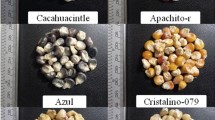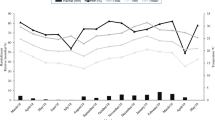Abstract
Host plant resistance is one of the most promising alternatives to insecticides to manage the shoot fly, Atherigona naqvii Steyskal, which is a major biotic constraint to spring sown maize in northern India. In present studies, Nineteen maize inbreds selected from diverse sources were characterized for resistance traits against shoot fly under its natural infestation using moistened fishmeal. Though the antixenosis to shoot fly for oviposition was not observed in the test genotypes. But, the presence of significant variation in the deadhearts incidence revealed the existence of relative amount of resistance among the test genotypes. The Tolerance (measured in the terms of less proportion of deadhearts out of total shoot fly incidence (leaf injury + deadhearts)) and Antibiosis (in terms of larval and pupal weight, duration and survival) were recognized as key mechanisms of this resistance. Tolerance to shoot fly was significantly more in resistant inbreds, SO1SHYQBBB13B, HK12-6-2-4, DMSC 28, CM 143 and Winpop 8 (29.46–36.56%) in comparison to the susceptible genotypes SE 563 and LM 16 (46.31–47.44%). The correlation and stepwise regression analyses revealed that the more seedling vigor, less leaf area, less number of leaves and thin stem had significant impact on the shoot fly deadhearts incidence and provided resistance against this pest. The total soluble sugars (TSS), proteins and amino acids were significantly higher in the susceptible inbreds; whereas, total phenols and tannins; and activities of defensive enzymes viz. phenylalanine ammonia lyase (PAL) and polyphenol oxidase (PPO) were significantly higher in resistant inbreds. Further, the stepwise regression revealed that the larval period, per cent pupation, pupal weight female, pupal weight male and adult emergence of shoot fly were significantly influenced by PAL activity, which explained 71.5, 82.9, 47.0, 29.8 and 39.9% of their total variation, respectively. PPO activity significantly influenced the pupal period (R2 = 59.7%) whereas, the larval weight was significantly influenced by amino acids (R2 = 56.9%), proteins (R2 = 10.2%) and TSS (R2 = 7.7%). So, the correlation and regression analyses revealed that these physico-chemical characters of the maize inbreds can be utilized as reliable markers traits to identify resistant sources to develop shoot fly resistant maize hybrids.








Similar content being viewed by others
References
Anonymous (2017) Package of practices for crops of Punjab Rabi. Punjab Agricultural University, Ludhiana, p 22
Archana S, Parbhakar K, Raghuchander T, Hubbali M, Valarmathi P, Prakasam V (2011) Defense responses of grapevine to Plasmopora viticola induced by Azoxystrobin and Pseudomonas fluorescens. Int J Sustain Agric 3:30–38
Arshad A, Munawar A, Ahmad F, Mastoi MI (2019) Varietal susceptibility of local and hybrid maize against Atherigona soccata (Diptera: Muscidae) under field conditions. J Entomol Zool Stud 7:36–41
Bernards M, Bastrup-Spohr L (2008) Phenylpropanoid metabolism induced by wounding and insect herbivory. In: Schaller A (ed) Induced plant resistance to herbivory. Springer-Verlag, New York, pp 189–211
Bhoge RS, Pawar DB, Dalvi US, Gadakh SR (2017) Physico–chemical mechanism of resistance to shoot fly Atherigona soccata (Rondani) in sorghum. Indian J Agric Biochem 30:80–84
Bueno AF, Carvalho GA, Santos AC, Sosa-Gómez DR, Silva DM (2017) Pesticide selectivity to natural enemies: challenges and constraints for research and field recommendation. Ciência Rural 47(06):e20160829
Burrell MM, Rees TA (1974) Metabolism of phenylalanine and tyrosine in rice leaves infected by Pyricularia oryzae. Physiol Plant Pathol 4:497–508
Chamarthi SK (2008) Biochemical mechanisms of resistance to shoot fly, Atherigona soccata (Rondani) in sorghum, Sorghum bicolor (L.) Moench. Ph. D. dissertation. Jawaharlal Nehru Technological University, Hyderabad, Andhra Pradesh, India
Chamarthi SK, Sharma HC, Sahrawat KL, Narasu LM, Dhillon MK (2011) Physico–chemical mechanisms of resistance to shoot fly, Atherigona soccata in sorghum, Sorghum bicolor. J Appl Entomol 135:446–455
Chapman RF, Simpson SJ, Douglas AE (2013) The insects: structure and function. Cambridge University Press, New York, pp 81–104
IBM Corp (2017) IBM SPSS Statistics for Windows, Version 25.0. Armonk, NY: IBM Corp
Dhillon MK, Sharma HC, Singh R, Naresh JS (2005) Mechanisms of resistance to shoot fly, Atherigona soccata in sorghum. Euphytica 144:301–312
Dubois M, Gilles KA, Hamilton JK, Rebers PA, Smith F (1956) Colorimetric method for determination of sugars and related substances. Anal Chem 28:350–356
Elahi M, Khan N (1973) Free amino acids of Pakistani wheat varieties. J Agric Food Chem 21:743–744
Hari NS, Jindal J (2008) Chemical control and damage potential of shoot fly, Atherigona naqvii Steyskal on spring sown maize. Indian J Plant Prot 36:263–265
Helmi A, Mohamed HI (2016) Biochemical and ultrastructural changes of some tomato cultivars after infestation with Aphis gossypii Glover (Hemiptera: Aphididae) at Qalyubiyah, Egypt. Gesunde Pflanzen 68:41–50
Jayanthi PDK, Reddy BVS, Gour TB, Reddy DDR (2002) Early seedling vigour in sorghum and its relationship with resistance to shoot fly, Atherigona soccata (Rondani). J Entomol Res 26:93–100
Jindal J (2013) Incidence of insect pests and management of shoot fly, Atherigona spp. in spring sown maize. Ph.D. dissertation. Punjab Agricultural University, Ludhiana, India
Jindal J, Hari NS, Grewal MS, Chawla JS (2007) Evaluation of different genotypes against shoot fly, Atherigona naqvii Steyskal in spring sown maize. Crop Improv 34:160–162
Kaur H, Salh PK, Singh B (2017) Role of defense enzymes and phenolics in resistance of wheat crop (Triticum aestivum L.) towards aphid complex. J Plant Interact 2:304–311
Kaur A, Vikal Y, Jindal J, Singh A, Singh P, Garg T (2018) Identification of quantitative trait loci for resistance to shoot fly in maize. I: Prasanna BM, Das A, Kaimenyi KK (ed) Book of Extended Summaries, 13th Asian Maize Conference and Expert Consultation on Maize for Food, Feed, Nutrition and Environmental Security. Ludhiana, India. pp 140–50
Khush GS, Panda N (1996) Host plant resistance to insects. Bull Entomol Res 86:315–316
Kumar R, Singh M, Kumar N (2014) Bionomics of Atherigona soccata (Rondani) on resistant and susceptible maize genotypes. Indian J Entomol 76:192–196
Kundu GG, Kishore P (1970) Biology of the sorghum shoot fly, Atherigona varia soccata (Rondani) (Anthomyiidae: Diptera). Indian J Entomol 32:215–217
Lowry OH, Rosebrough NJ, Farr AL, Randall RJ (1951) Protein measurement with the folin phenol reagent. J Biol Chem 188:265–275
Lu C, Warchol KM, Callahan RA (2014) Sub-lethal exposure to neonicotinoids impaired honey bees winterization before proceeding to colony collapse disorder. Bull Insectol 67:125–130
Marwaha KK, Siddiqui KH, Panwar VPS, Sarup P (1984) Peak period of activity of shoot fly species (Atherigona soccata Rondani and A. naqvii Steyskal) in spring sown maize germplasm. J Entomol Res 8:199–208
Meksongsee B, Chawanapong M, Sangkasuwan U, Poonyathaworn P (1981) The biology and control of the sorghum shoot fly, Atherigona soccata (Rondani) in Thailand. Insect Sci Applic 2:111–116
Padmaja PG, Shwetha BL, Swetha G, Patil JV (2014) Oxidative enzyme changes in sorghum infested by shoot fly. J Insect Sci 14:1–5
Pandey KC, Sharma VK (1980) Comparative susceptibility of some released and elite maize germplasm against shoot fly, Atherigona spp. in spring sown maize. Indian J Entomol 42:21–23
Panwar VPS (1995) Reaction of promising maize germplasm to shoot fly species (Atherigona soccata Rondani and A. naqvii Steyskal) in spring season. Indian J Entomol 57:70–72
Panwar VPS (2005) Management of shoot fly (Atherigona spp.) in spring sown maize in tropics. In: Zaidi PH, Singh NN (eds) Stresses on maize in tropics. Directorate of Maize Research, New Delhi, pp 376–395
Patel HV, Kalaria RK, Patel RM, Bhanderi GR (2015) Biochemical changes associated in different sorghum genotypes against shoot fly, Atherigona soccata (Rondani) resistant. Trends Biosci 8:2867–2871
Patil SP, Bagde AS (2017) Physio–chemical resistance mechanism of sorghum genotypes against shoot fly (Atherigona soccata) (Rondani). Int J Curr Microbiol App Sci 6:2742–2746
Patil SS, Narkhede BN, Barhate KK, Chaudhari GB (2005) Correlation among biochemical parameters and sorghum shoot fly resistance. Agric Sci Digest 25:26–28
Raina AK (1981) Movement, feeding behaviour and growth of larvae of the sorghum shoot fly, Atherigona soccata. Insect Sci Applic 2:71–81
Rana BS, Singh BU, Rao NGP (1985) Breeding for shoot fly and stem borer resistance in sorghum. In: Proceedings of the international sorghum entomology workshop, 15–21 July, 1984, Texas. A&M University, Texas, USA, pp 347–359
Rao CN, Panwar VPS (2001a) Morphological plant factors affecting resistance to Atherigona spp. in maize. Indian J Genet 61:314–317
Rao CN, Panwar VPS (2001b) Biochemical plant factors affecting resistance to Atherigona spp. in maize. Ann Plant Prot Sci 9:37–42
Riyazaddin M, Kishor PBK, Kumar AA, Reddy BVS, Munghate RS, Sharma HC (2015) Mechanisms and diversity of resistance to sorghum shoot fly, Atherigona soccata. Plant Breed 134:423–436
Sadasivam S, Manickam A (1992) Phenolics. Biochemical Methods for Agricultural Sciences. Wiley Eastern Ltd., New Delhi, pp 187–188
Sandhu GS, Kaushal KK (1976) Occurrence and biology of maize shoot fly in India. Entomol Rec 88:27
Sarup P, Panwar VPS (1987) Preferential plant age and site for oviposition by Atherigona naqvii Steyskal and Atherigona soccata Rondani in spring sown maize. J Entomol Res 11:150–154
Sarup P, Siddiqui KH, Marwaha KK, Panwar VPS (1984) Changing pest complex of maize as exemplified by the shoot fly (Atherigona spp.) preference for hosts in spring season. J Entomol Res 8:115–119
Sharma VK, Singh JM (1975) Screening for resistance to Atherigona spp. in spring sown maize. Indian J Entomol 37:39–43
Sharma HC, Nwanze KF, Subramanian V (1997) Mechanisms of resistance to insects and their usefulness in sorghum improvement. I: Sharma HC, Singh F, Nwanze KF (ed) Plant resistance to insects in sorghum. International Crops Research Institute for the Semi–Arid Tropics, Patancheru, Andhra Pradesh, India, pp 81–100
Siddiqui KH, Marwaha KK (1994) The Vistas of Maize Entomology in India. Kalyani Publishers, Ludhiana
Siddiqui KH, Marwaha KK, Sarup P (1988) Differential response of maize germplasm to shoot fly species, Atherigona soccata (Rondani) and Atherigona naqvii Steyskal under natural conditions. J Entomol Res 12:160–165
Singh SP, Jotwani MG (1980) Mechanisms of resistance in sorghum to shoot fly II. Antibiosis. Indian J Entomol 42:240–247
Singh BU, Padmaja PG, Seetharama N (2004) Stability of biochemical constituents and their relationships with resistance to shoot fly, Atherigona soccata (Rondani) in seedling sorghum. Euphytica 136:279–289
Srivastava KP, Young WR, Bhatia SK (1969) A new record of stem fly Atherigona naqvii Steyskal causing damage to barley. Indian J Entomol 31:290–291
Steyskal GC (1966) A new species of Atherigona rondani (Diptera: Muscidae) causing damage to wheat in West Pakistan. Proc Entomol Soc Washington 68:53–56
Swain T, Hillis WE (1959) The phenolic constituents of Prunus domestica: the quantitative analysis of phenolic constituents. J Sci Food Agric 10:63–68
War AR, Paulraj MG, Ahmad T, Buhroo AA, Hussain B, Ignacimuthu S, Sharma HC (2012a) Mechanisms of plant defense against insect herbivores. Plant Signal Behav 7:1306–1320
War AR, Paulraj MG, War MY, Ignacimuthu S (2012b) Differential defensive response of groundnut germplasms to Helicoverpa armigera (Hubner) (Lepidoptera: noctuidae). J Plant Interact 7:45–55
Author information
Authors and Affiliations
Corresponding author
Additional information
Publisher's Note
Springer Nature remains neutral with regard to jurisdictional claims in published maps and institutional affiliations.
Rights and permissions
About this article
Cite this article
Goyal, S., Jindal, J. & Kaur, K. Physico-chemical bases of resistance in maize against shoot fly, Atherigona naqvii Steyskal during spring season in north India. Euphytica 216, 154 (2020). https://doi.org/10.1007/s10681-020-02665-z
Received:
Accepted:
Published:
DOI: https://doi.org/10.1007/s10681-020-02665-z




